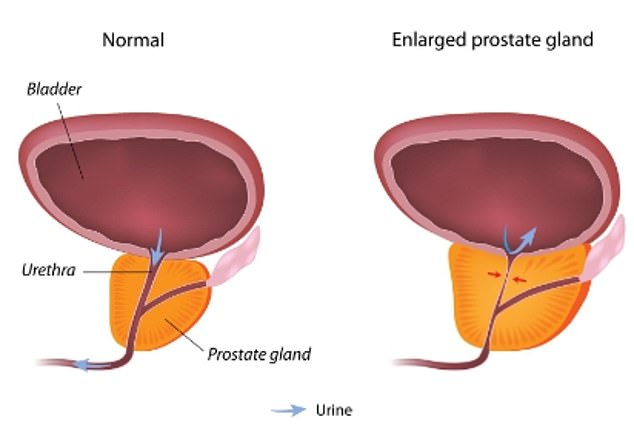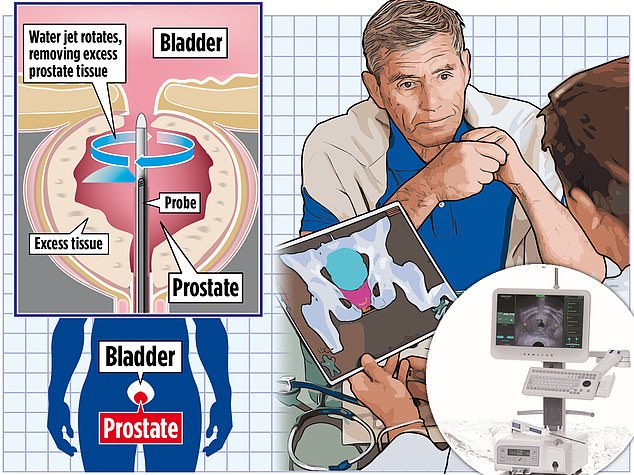What IS an enlarged prostate? As has been revealed, King Charles will have him treated in hospital, the ultimate guide to a condition that affects HALF of all men by the time they are 60.
It is a condition that will affect about half of people in their lifetime, from kings to commoners.
As revealed by King Charles III going to the hospital next week for treatment for an enlarged prostate. We explain that you must be aware of the condition.
Enlarged prostate, like the one King Charles will be treated for, is not carcinogenic, nor does it increase the risk of developing prostate cancer in the future.
The prostate itself is a small gland found only in men and located in the pelvis between the penis and the bladder.
It is part of the male reproductive system and produces a fluid that mixes with semen to produce semen.
King Charles III will go to hospital next week to be treated for an enlarged prostate

This NHS diagram shows how an enlarged prostate can press on the bladder and narrow the urethra, a process that can cause a variety of urinary problems
However, the gland, normally the size of a walnut, can triple to the size of a tennis ball due to a condition doctors call benign prostate enlargement (BPE).
This enlargement can cause a range of symptoms as the prostate begins to press on the bladder and narrow the urethra.
These usually include finding it difficult to urinate, having tension or having a ‘stop-start’ movement, or having to urinate urgently or frequently, especially at night.
A particularly embarrassing symptom of BPE is incontinence, where patients sometimes accidentally urinate when they don’t mean it.
The exact cause of the condition – which typically affects half of men in their 50s and up to 90 percent of men over 80 – is not yet fully understood.
But doctors suspect it is related to hormonal changes that men experience as they age, which is why it usually occurs when they reach a certain age.
One theory is that as testosterone levels drop, the prostate is no longer regulated by the body in the same way, causing a growth spurt.
BPE is usually first discovered by a GP treating a patient who has come to him with urinary problems.
The doctor may perform a rectal examination on a patient to feel the size of the prostate to see if their urinary problems are caused by the gland.
A patient is then usually referred to a specialist urologist for treatment, although other tests are generally ordered to ensure that it is in fact BPE and nothing more sinister.
Once BPE is confirmed, a patient may receive different types of treatments depending on how severely the symptoms affect their quality of life.
At the lower end of the scale, lifestyle changes are recommended, such as drinking less alcohol, caffeine, and other substances that irritate the bladder and worsen urinary problems.
Non-pharmaceutical measures such as sanitary pads or urine wraps, which are condom-like devices designed to collect urine and can be worn in a man’s pants, may also be recommended.
If these measures do not work, various medications that relax or medically shrink the muscles in the prostate may be prescribed.
Other medications that slow the production of urine or cause you to urinate more often during the day than at night may also be given to help control BPE symptoms.
Although most men with BPE do not need to undergo surgery or a procedure, as Charles would have to do, this is an option in cases where other treatments have not worked or if symptoms are severe.
These include forms of surgery that use small tools that pass through the urethra, the inner tube of the penis through which urine and semen travel, to cut away part of the prostate, sometimes using a laser to do this to do.
There are other newer techniques that are not routinely available on the NHS that can also be used as an alternative.
The first is a technique called water ablation, in which water or steam is pumped directly into the prostate using a special probe.
This creates pressure that destroys some of the prostate tissue, causing it to shrink.

One possible treatment option is a procedure called water ablation. The National Institute for Health and Care Excellence (NICE) recently recommended that doctors in England offer this as a first-line treatment for enlarged prostate, although the NHS warns that availability is limited because many surgeons have not yet been trained in the technique.
Another technique, called Greenlight XPS, works similarly, but uses a laser instead of water or steam to directly destroy prostate tissue.
Other techniques include using tissue from the intestines to enlarge the bladder to reduce BPE symptoms or inserting a special implant to create a buffer between the prostate and bladder wall.
Some medical professionals also advise that the best way to prevent prostate problems later in life is to make sure it is used, in other words by having sex or masturbating, although there is no hard evidence for this yet.
Other positive health factors, such as a healthy diet and regular exercise, are also thought to help or delay the onset of BPE, or reduce the likelihood of symptoms.
It is not known what type of treatment Charles will receive. Assistants describe it only as a “corrective procedure.”
In a statement issued at 3.30pm today, a Buckingham Palace spokesperson said: ‘Like thousands of men every year, the King has sought treatment for an enlarged prostate.
“His Majesty’s condition is benign and he will attend hospital next week for a corrective procedure. The King’s public appearances will be postponed for a short period of recovery.”
It is unusual for the palace to reveal so many details about Charles’ health, but royal sources said he was keen to share details of his diagnosis to encourage other men who may be experiencing symptoms to get checked, in line with public health advice. .
It comes after Kensington Palace said separately at 2pm that the Princess of Wales was being treated in hospital following a successful abdominal operation.
Kate, 42, was admitted to the London Clinic yesterday for the planned procedure and is expected to remain in hospital for 10 to 14 days before returning home. She will then recover and be away from official duties for up to three months.
As for Charles, he had a series of meetings and events planned at Dumfries House in Ayrshire today and tomorrow, which have now been postponed on doctor’s advice.
Guests, including foreign dignitaries and members of the Cabinet, were due to travel to Scotland and the palace made this announcement to alert them to the situation.
The 75-year-old monarch acceded to the throne just 16 months ago, after spending 70 years as heir apparent, and was crowned at Westminster Abbey last May.
